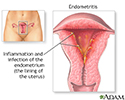Endometritis
Endometritis is an inflammation or irritation of the lining of the uterus (the endometrium). It is not the same as endometriosis.
Endometritis is caused by an infection in the uterus. It can be due to chlamydia, gonorrhea, tuberculosis, or a mix of normal vaginal bacteria. It is more likely to occur after miscarriage or childbirth. It is also more common after a long labor or C-section.
The risk for endometritis is higher after having a pelvic procedure that is done through the cervix. Such procedures include:
- D and C (dilation and curettage)
- Endometrial biopsy
- Hysteroscopy
- Placement of an intrauterine device (IUD)
- Childbirth (more common after C-section than vaginal birth)
Endometritis can occur at the same time as other pelvic infections.
Symptoms
Symptoms may include:
- Swelling of the abdomen
- Abnormal vaginal bleeding or discharge
- Discomfort with bowel movement (including constipation)
- Fever
- General discomfort, uneasiness, or ill feeling
- Pain in lower abdomen or pelvic region (uterine pain)
Exams and Tests
The health care provider will perform a physical exam with a pelvic exam. Your uterus and cervix may be tender and the provider may not hear bowel sounds. You may have cervical discharge.
The following tests may be performed:
- Cultures from the cervix for chlamydia, gonorrhea, and other organisms
- Endometrial biopsy
- ESR (erythrocyte sedimentation rate)
- Laparoscopy
- WBC (white blood count)
- Wet prep (microscopic exam of any discharge)
Treatment
You will need to take antibiotics to treat the infection and prevent complications. Finish all your medicine if you have been given antibiotics after a pelvic procedure. Also, go to all follow-up visits with your provider.
You may need to be treated in the hospital if your symptoms are severe or occur after childbirth.
Other treatments may involve:
- Fluids through a vein (by IV)
- Rest
Sexual partners may need to be treated if the condition is caused by a sexually transmitted infection (STI).
Outlook (Prognosis)
In most cases, the condition goes away with antibiotics. Untreated endometritis can lead to more serious infections and complications. Rarely, it may be associated with a diagnosis of endometrial cancer.
Possible Complications
Complications may include:
- Infertility
- Pelvic peritonitis (generalized pelvic infection)
- Pelvic or uterine abscess formation
- Septicemia
- Septic shock
When to Contact a Medical Professional
Call your provider if you have symptoms of endometritis.
Call right away if symptoms occur after:
- Childbirth
- Miscarriage
- Abortion
- IUD placement
- Surgery involving the uterus
Prevention
Endometritis may be caused by STIs. To help prevent endometritis from STIs:
- Treat STIs early.
- Make sure sexual partners are treated in the case of a STI.
- Follow safer sex practices, such as using condoms.
Women having a C-section may have antibiotics before the procedure to prevent infections.
References
Centers for Disease Control and Prevention website. Sexually transmitted infections treatment guidelines, 2021. www.cdc.gov/std/treatment-guidelines/default.htm. Updated July 22, 2021. Accessed August 31, 2021.
Duff WP. Maternal and perinatal infection in pregnancy: bacterial. In: Landon MB, Galan HL, Jauniaux ERM, et al, eds. Gabbe's Obstetrics: Normal and Problem Pregnancies. 8th ed. Philadelphia, PA: Elsevier; 2021:chap 58.
Eckert LO, Lentz GM. Genital tract infections: vulva, vagina, cervix, toxic shock syndrome, endometritis, and salpingitis. In: Gershenson DM, Lentz GM, Valea FA, Lobo RA, eds. Comprehensive Gynecology. 8th ed. Philadelphia, PA: Elsevier; 2022:chap 23.
Review Date: 7/13/2021
Reviewed By: John D. Jacobson, MD, Department of Obstetrics and Gynecology, Loma Linda University School of Medicine, Loma Linda, CA. Also reviewed by David Zieve, MD, MHA, Medical Director, Brenda Conaway, Editorial Director, and the A.D.A.M. Editorial team.












